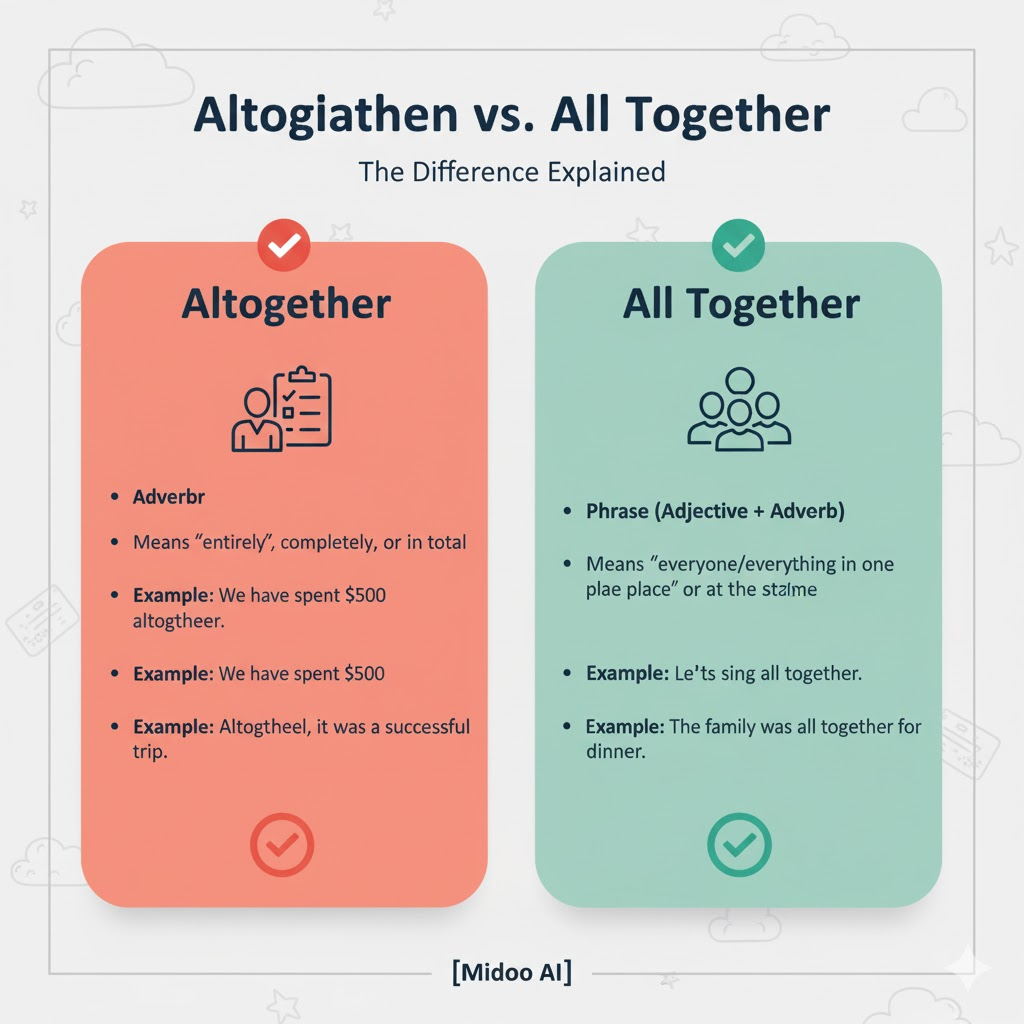Altogether vs. All Together — What’s the Differenc

English can be tricky, especially when two expressions sound identical but mean entirely different things. A perfect example is “altogether” and “all together.”
At Midoo AI, we know how easy it is to mix up words that look almost the same. That’s why we’re breaking down the difference between altogether (one word) and all together (two words) — so you can write naturally and confidently every time.
1. The Core Difference
- Altogether (one word) means completely, entirely, or in total.
- All together (two words) means everyone or everything in the same place or at the same time.
So the difference comes down to meaning and function — altogether is an adverb, while all together is a phrase referring to a group.
2. How to Use “Altogether”
Altogether is used when you want to express a sense of wholeness, totality, or completeness.
Examples:
- It’s not altogether clear what she meant.
- We spent $500 altogether on our vacation.
- The plan failed altogether after the last meeting.
- She stopped visiting altogether after the argument.
Tip: If you can replace it with completely or entirely, use altogether.
3. How to Use “All Together”
All together refers to people or things being in the same place, at the same time, or acting collectively.
Examples:
- Let’s sing all together now!
- The students sat all together in the front row.
- It’s nice to have the family all together again.
- The files were placed all together in one folder.
Tip: If you can add the word everyone or everything and the meaning still fits, it’s all together.
4. Quick Comparison Table
| Meaning | Example | Can Replace With |
|---|---|---|
| Altogether – completely, entirely | It’s not altogether true. | completely / entirely |
| Altogether – in total | The bill was $300 altogether. | in total |
| All together – everyone/everything in one group | The family is all together now. | everyone together |
| All together – at the same time | They shouted all together. | simultaneously |
5. Common Mistakes to Avoid
❌ It’s not all together clear what happened.
✅ It’s not altogether clear what happened.
❌ The team worked altogether on the project.
✅ The team worked all together on the project.
Tip: If you’re describing clarity or completeness, use altogether.
If you’re describing a group or action done collectively, use all together.
6. Easy Memory Trick
Think of it this way:
- Altogether = All as one word → one total meaning.
- All together = All as separate → separate people or things together.
So, if the concept itself is united, use altogether.
If people or items are physically or conceptually grouped, use all together.
7. Real-Life Examples
- The trip was altogether too short for me. → “too short overall.”
- We were all together for the holiday dinner. → “everyone was there.”
- That’s altogether a different issue. → “completely different.”
- Let’s move all together to the next room. → “everyone moves.”
FAQ
Q1: Can “altogether” start a sentence?
Yes! It can be used at the beginning to emphasize a point, like:
Altogether, the event was a great success.
Q2: Is “altogether” more formal than “all together”?
Not really. They’re just used in different contexts — one’s an adverb, the other a phrase.
Q3: Are both used in American and British English?
Yes. There’s no regional difference here — the meanings are the same across English varieties.
Q4: How do I test which one to use?
Try replacing the word with completely or entirely.
If it works, use altogether.
If not, and the sentence talks about a group, use all together.
Q5: Can both appear in the same sentence?
Absolutely! For example:
It’s altogether wonderful to see everyone all together again.